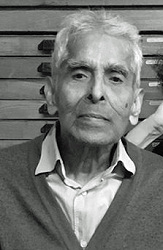N. Krishna Reddy
American, born India
American, born India, (1925–2018)
Reddy studied at Visva-Bharati University's Kala Bhavana (Institute of Fine Arts) with Nandalal Bose, from 1941 to 1946, and graduated with a degree in fine arts. From 1947 to 1949, he was head of the art section at Kalakshetra Foundation and was also teaching art at the Montessori Teachers' Training Centre in Madras. It was at this time that he took interest in sculpture and painting. In 1949, he moved to London, and continued his sculpture studies with Henry Moore at the University of London's Slade School of Fine Arts. In 1950, Reddy moved to Paris and met artist Constantin Brâncuși. Through Brâncuși, he was introduced to cafe discussions on art and met many famous artists during studio visits.[4] During his time in Paris he studied sculpture under Ossip Zadkine and engraving under Stanley William Hayter.
In 1957, he traveled to Academia Di Belle Arti Di Brera (Brera Academy) in Milan to study under Marino Marini. In 2016 he was one of the subjects of the exhibition Workshop and Legacy: Stanley William Hayter, Krishna Reddy, Zarina Hashmi at the Metropolitan Museum of Art. Reddy was considered a master in intaglio printmaking and after 1965 was an associate director at Hayter's Atelier 17. Atelier 17, a thriving artist workshop was founded in 1927 by Hayter and was originally located in Paris; however between 1939 and 1940 the workshop moved to New York City and in 1950 back to Paris. Atelier 17 has always been a meeting place to experiment with their art practices for both European and American artists including Joan Miró, Pablo Picasso, Alberto Giacometti, Juan Cardenas, Constantin Brâncuși, and Zarina Hashmi.
Reddy's technique and style distinguished him as an important printmaker. Reddy's prints are abstract, created with subtle grid-like designs on plates with intricate texturisations. The myriad complex colour that he introduced in prints are marked by a contemplative approach to the infinite mysteries of nature. While working at Atelier 17, Reddy was instrumental in developing a new printing process to produce multi-coloured prints from a single printing matrix by exploiting the viscosity and tackiness of the inks, subsequently named viscosity printing. Reddy received the Padma Shri award in 1972, in recognition of his distinguished contributions to art.
Source: wikipedia.org
American, born India
American, born India, (1925–2018)
Reddy studied at Visva-Bharati University's Kala Bhavana (Institute of Fine Arts) with Nandalal Bose, from 1941 to 1946, and graduated with a degree in fine arts. From 1947 to 1949, he was head of the art section at Kalakshetra Foundation and was also teaching art at the Montessori Teachers' Training Centre in Madras. It was at this time that he took interest in sculpture and painting. In 1949, he moved to London, and continued his sculpture studies with Henry Moore at the University of London's Slade School of Fine Arts. In 1950, Reddy moved to Paris and met artist Constantin Brâncuși. Through Brâncuși, he was introduced to cafe discussions on art and met many famous artists during studio visits.[4] During his time in Paris he studied sculpture under Ossip Zadkine and engraving under Stanley William Hayter.
In 1957, he traveled to Academia Di Belle Arti Di Brera (Brera Academy) in Milan to study under Marino Marini. In 2016 he was one of the subjects of the exhibition Workshop and Legacy: Stanley William Hayter, Krishna Reddy, Zarina Hashmi at the Metropolitan Museum of Art. Reddy was considered a master in intaglio printmaking and after 1965 was an associate director at Hayter's Atelier 17. Atelier 17, a thriving artist workshop was founded in 1927 by Hayter and was originally located in Paris; however between 1939 and 1940 the workshop moved to New York City and in 1950 back to Paris. Atelier 17 has always been a meeting place to experiment with their art practices for both European and American artists including Joan Miró, Pablo Picasso, Alberto Giacometti, Juan Cardenas, Constantin Brâncuși, and Zarina Hashmi.
Reddy's technique and style distinguished him as an important printmaker. Reddy's prints are abstract, created with subtle grid-like designs on plates with intricate texturisations. The myriad complex colour that he introduced in prints are marked by a contemplative approach to the infinite mysteries of nature. While working at Atelier 17, Reddy was instrumental in developing a new printing process to produce multi-coloured prints from a single printing matrix by exploiting the viscosity and tackiness of the inks, subsequently named viscosity printing. Reddy received the Padma Shri award in 1972, in recognition of his distinguished contributions to art.
Source: wikipedia.org
Artist Objects
Three Graces 1998.043


